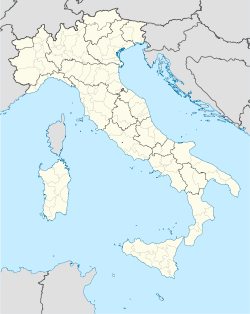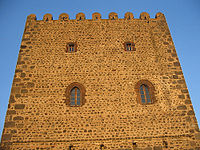- Motta Sant'Anastasia
-
Motta Sant'Anastasia — Comune — Comune di Motta Sant'Anastasia Location of Motta Sant'Anastasia in Italy Coordinates: 37°30′N 14°58′E / 37.5°N 14.967°ECoordinates: 37°30′N 14°58′E / 37.5°N 14.967°E Country Italy Region Sicily Province Province of Catania (CT) Frazioni Piano Tavola Area - Total 35.7 km2 (13.8 sq mi) Elevation 275 m (902 ft) Population (Dec. 2007) - Total 11,203 - Density 313.8/km2 (812.8/sq mi) Demonym Mottesi Time zone CET (UTC+1) - Summer (DST) CEST (UTC+2) Postal code 95040 Dialing code 095  Close-up of Motta Sant'Anastasia, Belpasso is on the background.
Close-up of Motta Sant'Anastasia, Belpasso is on the background.
Motta Sant'Anastasia is a comune (municipality) in the Province of Catania in the Italian region Sicily, located about 160 km southeast of Palermo and about 9 km west of Catania. As of 31 December 2007, it had a population of 11,203 and an area of 35.7 km².[1]
The municipality of Motta Sant'Anastasia contains the frazione (subdivision) Piano Tavola and also the Naval Air Station Sigonella. The latter accounts for the substantial numbers of American military personnel and their families who reside in Motta Sant'Anastasia.
Motta Sant'Anastasia borders the following municipalities: Belpasso, Camporotondo Etneo, Catania, Misterbianco.
Giuseppe Di Stefano was a native of Motta Sant'Anastasia.
Contents
History
Motta, like other cities in the Simeto Valley, has ancient origins. Archaeological studies dating back to 1954 in contrada Ardizzone, attest Greek presence in the territory around the 5th–4th centuries BC. The Roman period, however, was evidenced by the discovery of some coins from the period of the great empire, and a mosaic found in contrada Acquarone , belonging to a villa.
On behalf of Motta Sant'Anastasia name there are several hypotheses. According to some scholars Motta (pre-Roman name) and Anastasia (Greek-Byzantine name) have similar meanings and indicate the nature of the place, the typical relief of the territory that has been characterized by the Neck and the surrounding area of Motta Sant'Anastasia. Later in the 12th–14th centuries, the two names were combined and citizens joined in devotion and worship of Sant'Anastasia, patroness of the town.
Motta, since the period of Dionysus, tyrant of Syracuse, has held a role of considerable importance as a stronghold of warning and defence.
This role grew during the Norman period with Ruggero d'Altavilla, who had built a tower to guard the entrance of the plain of Catania and protect the possessions of the Normans from Saracen incursions. The characteristics of the area, the remains of defensive structures and housing highlight the typical medieval town. "La Motta", in fact, consisted of an elevated place from where it was possible to control the entire territory. In England, around 1066, on "Motta" of places of conquest, the Normans built a wooden tower to defend the occupied territories. But in Sicily, for the lack of forests, the Normans had to build their towers with basalt stone. At "Motta" this construction was facilitated by the morphological conformation of the place, that it lends itself well to building the defensive outpost.
The first settlement outside the walls was the district Urnazza that, around 1500, was erected near the church of St. Anthony, then the place of burial for the neighborhoods "Urnazza" and "Matrix." In 1526 the city became a fief of Antonio Moncada, Count of Adernò, and for four centuries, until 1900, the castle was intended to be a prison.
In the second half of 1600 there were 560 inhabitants in Motta. Between the second half of 1700 and 1800 there was the beginning of the development of the structure of the town, with the birth of new neighborhoods, such as "Cross", "Well," "Sciddichenti". In 1798 the inhabitants of Motta became 1400 and in the census of 1831 arrived to 2181. On 1 January 1820 the Court of Catania founded the town of Motta Sant'Anastasia.
The Neck
The Neck is the rock upon which the oldest part of Motta Sant'Anastasia was built, and it is of volcanic origin. A long and intense eruption dating back to 550,000 years ago caused the formation of a volcanic cone. Over the centuries, due to the processes of erosion, the cone has acquired its current shape named "columnar rocks", a prismatic hexagonal and pentagonal section more or less regular, reaching a height of 65 meters.
Motta is one of the only example of "Neck" in Italy. Other cases are found in France (Le Puy of Velay) in Algeria (Tamanrasset-Ahaggar) and USA (Missouri, Montana, Arizona, Utah, New Mexico). The vegetation on the rock is made up of lichens and Indian fig (Opuntia Ficus Indica Mill).
The Norman tower (Dongione)
The Tower of Motta (or "Dongione") was built between 1070 and 1074 (it seems on the ruins of an Arabic tower) by the will of the great Count Roger the Norman. The massive tower with a rectangular plan (with dimensions: 21.54 x 9 x 17.10 m) is about 21 meters high and is a typical defensive structure of the late Middle Ages. The roof terrace retains almost intact battlements (22 merlons with rounded head).
The structure consists of three elevations. Only the first of these is still the original arched windows ogive (external) and at all sixth (inside). The other two square windows, on other levels, such as the current front door, go back to the 15th century.
The ground floor was designed for military housing. In it there are a number of holes for defence.
Demographic evolution

References
Sicily · Comuni of the Province of Catania Aci Bonaccorsi · Aci Castello · Aci Catena · Aci Sant'Antonio · Acireale · Adrano · Belpasso · Biancavilla · Bronte · Calatabiano · Caltagirone · Camporotondo Etneo · Castel di Iudica · Castiglione di Sicilia · Catania · Fiumefreddo di Sicilia · Giarre · Grammichele · Gravina di Catania · Licodia Eubea · Linguaglossa · Maletto · Maniace · Mascali · Mascalucia · Mazzarrone · Militello in Val di Catania · Milo · Mineo · Mirabella Imbaccari · Misterbianco · Motta Sant'Anastasia · Nicolosi · Palagonia · Paternò · Pedara · Piedimonte Etneo · Raddusa · Ragalna · Ramacca · Randazzo · Riposto · San Cono · San Giovanni la Punta · San Gregorio di Catania · San Michele di Ganzaria · San Pietro Clarenza · Sant'Agata li Battiati · Sant'Alfio · Santa Maria di Licodia · Santa Venerina · Scordia · Trecastagni · Tremestieri Etneo · Valverde · Viagrande · Vizzini · Zafferana EtneaCategories:- Cities and towns in Sicily
- Municipalities of the Province of Catania
Wikimedia Foundation. 2010.


